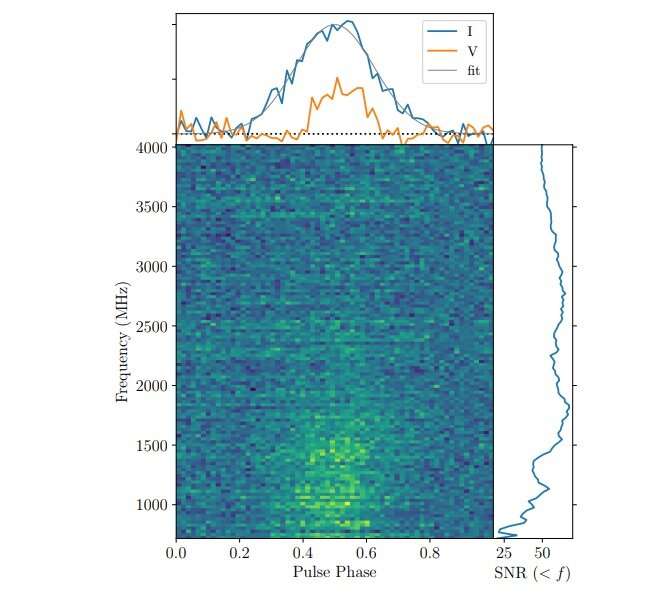August 13, 2019 report
New millisecond pulsar discovered

Astronomers have reported a serendipitous discovery of a new millisecond pulsar as part of an observational campaign using the Australian Square Kilometre Array Pathfinder (ASKAP) telescope. The newly detected pulsar has a spin period of about 2.77 ms and received designation PSR J1431−6328. The finding is detailed in a paper published August 8 on the arXiv pre-print repository.
Pulsars are highly magnetized, rotating neutron stars emitting a beam of electromagnetic radiation. The most rapidly rotating pulsars, with rotation periods below 30 milliseconds, are known as millisecond pulsars (MSPs).
One of methods to identify new pulsars is searching for the circularly polarized emission that is almost unique to objects of this type. A team of astronomers led by David L. Kaplan of University of Wisconsin-Milwaukee, employed this method using ASKAP.
The researchers have identified a highly polarized steep spectrum point source, designated ASKAP 143121.2−632809, in a deep pointing with ASKAP at 888 MHz. After rejecting the stellar origin of this newly found source, they classified it as a new MSP and gave it the designation PSR J1431−6328.
"The Parkes observations confirm discovery of a pulsar associated with ASKAP 143121.2−632809." the astronomers wrote in the paper.
As noted in the paper, the newly identified pulsar has a spin period of approximately 2.77 ms and dispersion measure at a level of about 228.27 parsecs/cm3. The pulsar's mass is estimated to be around 1.4 solar masses.
Like more than half of known MSPs, PSR J1431−6328 was found to have a companion star. The astronomers assume that the secondary star could be a white dwarf with an estimated mass of about 0.31 solar masses. The system's period was calculated to be most likely 64.3 days.
The researchers noted that although PSR J1431−6328 does not yet appear to be particularly remarkable, it was relatively hard to discover. This is due to its short spin period, wide profile and high dispersion measure, what make it challenging to find it through traditional blind periodicity searches.
"Note that while this pulsar was detectable in the HTRU [high time resolution-south] observation, the low period and high DM [dispersion measure] mean that it does rank rather low in 'detectability,'" the astronomers wrote.
Therefore, the discovery of PSR J1431−6328 proves that ASKAP could discover MSPs that are hard to find via traditional surveys. The researchers note that generic deep and shallow ASKAP surveys at 900 MHz, in particular, have the potential of finding more sources like the newly detected pulsar, including MSPs.
"For a 15 percent polarized fraction, a deep ASKAP survey is as competitive as the HTRU high-latitude survey. Moreover, MSPs have a larger scale galactic height compared to normal pulsars, suggesting that all-sky ASKAP surveys may discover a number of high-|b| MSPs," the researchers concluded.
More information: Serendipitous Discovery of PSR J1431-6328 as a Highly-Polarized Point Source with the Australian SKA Pathfinder, arXiv:1908.03163. arxiv.org/pdf/1908.03163.pdf
© 2019 Science X Network




















